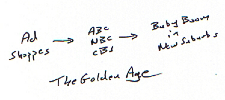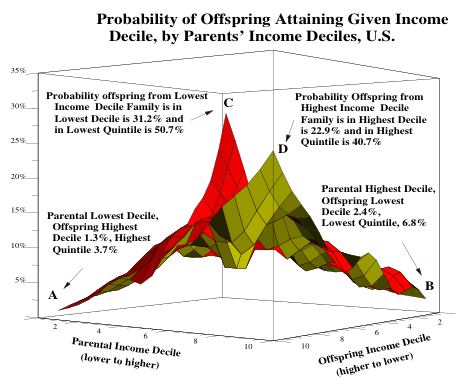I was raised by wolfs, well academics actually, and so it was only very late in life I learned that all stories are required to have three legs: problem, hero, and movement toward resolution. The power of this rule is demonstrated by how far some authors will stretch to fit. An example is a piece in the current New Yorker. Where the heroine is an advertising professional, and her problem is the end of the Golden age of advertising.
 To hear tell in the golden age of advertising little shoppes of advertising artisans lined the streets of Manhattan. As the curtain rises, desperate mouthwash manufacturing mogels would travel to this village and step into one of these shops. He would, of course, be carrying a few million dollars. In the second act the shop owner would craft a campaign and place it on the three television networks. In the third act the American public would tune and discover they had an unfulfilled desire to gargle more. As the curtain goes down they are all placing bottles of mouthwash into their shopping carts at the A&P.
To hear tell in the golden age of advertising little shoppes of advertising artisans lined the streets of Manhattan. As the curtain rises, desperate mouthwash manufacturing mogels would travel to this village and step into one of these shops. He would, of course, be carrying a few million dollars. In the second act the shop owner would craft a campaign and place it on the three television networks. In the third act the American public would tune and discover they had an unfulfilled desire to gargle more. As the curtain goes down they are all placing bottles of mouthwash into their shopping carts at the A&P.
This golden age amuses me. On the one hand you have numerous little firms and on the hand you have three huge television networks. It’s the canonical industry structure. On the one hand you have a highly consolidated distribution channel and on the other hand you have a long tail of tiny producers. In the nostalgic telling this is a beautiful thing. The small firms were wonderful because it they gave free reign (free-range?) to the heroic creative folk. The big networks were wonderful because they had aggregated the audience in a so convenient a package that it took one dance number late in the second act to deploy your campaign. During this scene money would rain down upon the stage.
To hear tell the golden age has ended. The advertising industry has condensed. The entertainment industry is more of a slush.
The article fails, in the end, to fit the required story template. The article is reduced to an enumeration of the various species emerging in the genus advertising. Not that, a kind of butterfly collecting, is something the child of academics can appreciate.
Here’s an interesting butterfly: 20 seconds of in-show product placement costs about the same amount as a 30 second ad. I would have assumed it costs more. About 40% more is spent on internet advertising than on product placement, but both are growing fast. Here’s another butterfly: Some newspapers are custom printed at the granularity of the postal code.
 Distribution channels fascinate me. Part of my fascination is the way they are fundamentally two faced; the distribution firm must balance between two strong forces. So an entertainment/advertising channel is trying to find a balance between the desires of it’s advertisers and the desires of it’s audience. Actually it’s got three faces, which is even more fun, but let’s gloss over that today. This tension is the ecology within which these butterflies evolve.
Distribution channels fascinate me. Part of my fascination is the way they are fundamentally two faced; the distribution firm must balance between two strong forces. So an entertainment/advertising channel is trying to find a balance between the desires of it’s advertisers and the desires of it’s audience. Actually it’s got three faces, which is even more fun, but let’s gloss over that today. This tension is the ecology within which these butterflies evolve.
Bewitched, the old sitcom about an ad executive living in the suburbs married to a witch, must be the perfect example of what emerges from an environment with such forces. It’s a show about the customer on both sides of the advertiser/audience channel! And, it is also the perfect venue for product placement.
The channels in the advertising universe – defined by the advertisers and audience it attracts – must strike a balance. Here’s another butterfly: the article tells a story of a TV show in which one of the characters takes a job pitching a product at the local mall, his pitch is identical to the ads spots broadcast with the show.
Billions and billions of ad channels are emerging. Google’s adsense is an example of that. That creates a bloom of new species of advertising channels. Some venues try to maximize how much they serve the advertiser, some try to maximize how much they serve the audience. Some venues don’t even choose to play in this game. The nostalgia for the golden age of advertising is the usual nostalgia for a time when the rules were well understood. The networks defined the audience and the manufactures and advertisers created products and campaigns to fit. Diversity is so confusing.
 Via
Via 

 To hear tell in the golden age of advertising little shoppes of advertising artisans lined the streets of Manhattan. As the curtain rises, desperate mouthwash manufacturing mogels would travel to this village and step into one of these shops. He would, of course, be carrying a few million dollars. In the second act the shop owner would craft a campaign and place it on the three television networks. In the third act the American public would tune and discover they had an unfulfilled desire to gargle more. As the curtain goes down they are all placing bottles of mouthwash into their shopping carts at the A&P.
To hear tell in the golden age of advertising little shoppes of advertising artisans lined the streets of Manhattan. As the curtain rises, desperate mouthwash manufacturing mogels would travel to this village and step into one of these shops. He would, of course, be carrying a few million dollars. In the second act the shop owner would craft a campaign and place it on the three television networks. In the third act the American public would tune and discover they had an unfulfilled desire to gargle more. As the curtain goes down they are all placing bottles of mouthwash into their shopping carts at the A&P. Distribution channels fascinate me. Part of my fascination is the way they are fundamentally two faced; the distribution firm must balance between two strong forces. So an entertainment/advertising channel is trying to find a balance between the desires of it’s advertisers and the desires of it’s audience. Actually it’s got three faces, which is even more fun, but let’s gloss over that today. This tension is the ecology within which these butterflies evolve.
Distribution channels fascinate me. Part of my fascination is the way they are fundamentally two faced; the distribution firm must balance between two strong forces. So an entertainment/advertising channel is trying to find a balance between the desires of it’s advertisers and the desires of it’s audience. Actually it’s got three faces, which is even more fun, but let’s gloss over that today. This tension is the ecology within which these butterflies evolve.